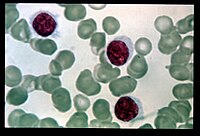
Photo from wikipedia
Acute lymphoblastic leukaemia (ALL) is the most common childhood malignancy with the majority of patients being classified as B-cell lineage (B-ALL). The sub-classification of B-ALL is based on genomic architecture.… Click to show full abstract
Acute lymphoblastic leukaemia (ALL) is the most common childhood malignancy with the majority of patients being classified as B-cell lineage (B-ALL). The sub-classification of B-ALL is based on genomic architecture. Recent studies have demonstrated the capability of SNP-microarrays to detect genomic changes in B-ALL which cannot be observed by conventional cytogenetic methods. In current clinical trials, B-ALL patients at high risk of relapse are mainly identified by adverse cancer genomics and/or poor response to early therapy. To test the hypothesis that inclusion of SNP-microarrays in frontline diagnostics could more efficiently and accurately identify adverse genomic factors than conventional techniques, we evaluated the Australian high-risk B-ALL cohort enrolled on AIEOP-BFM ALL 2009 study (n = 33). SNP-microarray analysis identified additional aberrations in 97% of patients (32/33) compared to conventional techniques. This changed the genomic risk category of 24% (8/33) of patients. Additionally, 27% (9/33) of patients exhibited a 'hyperdiploid' genome, which is generally associated with a good genomic risk and favourable outcomes. An enrichment of IKZF1 deletions was observed with one third of the cohort affected. Our findings suggest the current classification system could be improved and highlights the need to use more sensitive techniques such as SNP-microarray for cytogenomic risk stratification in B-ALL.
Journal Title: Cancer genetics
Year Published: 2020
Link to full text (if available)
Share on Social Media: Sign Up to like & get
recommendations!